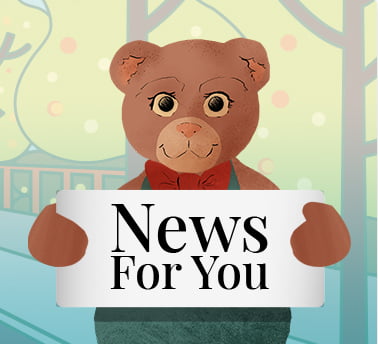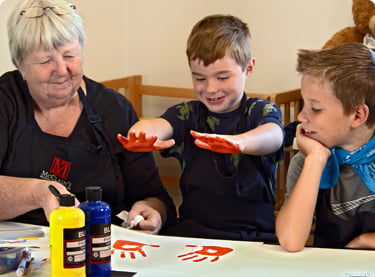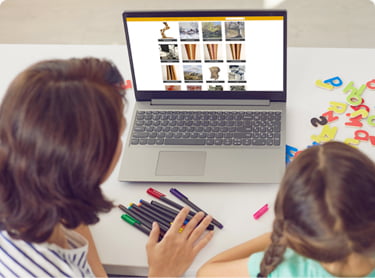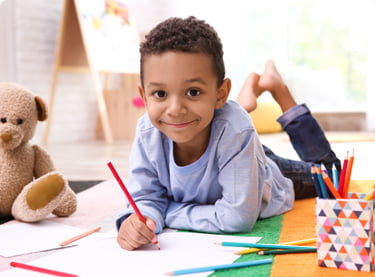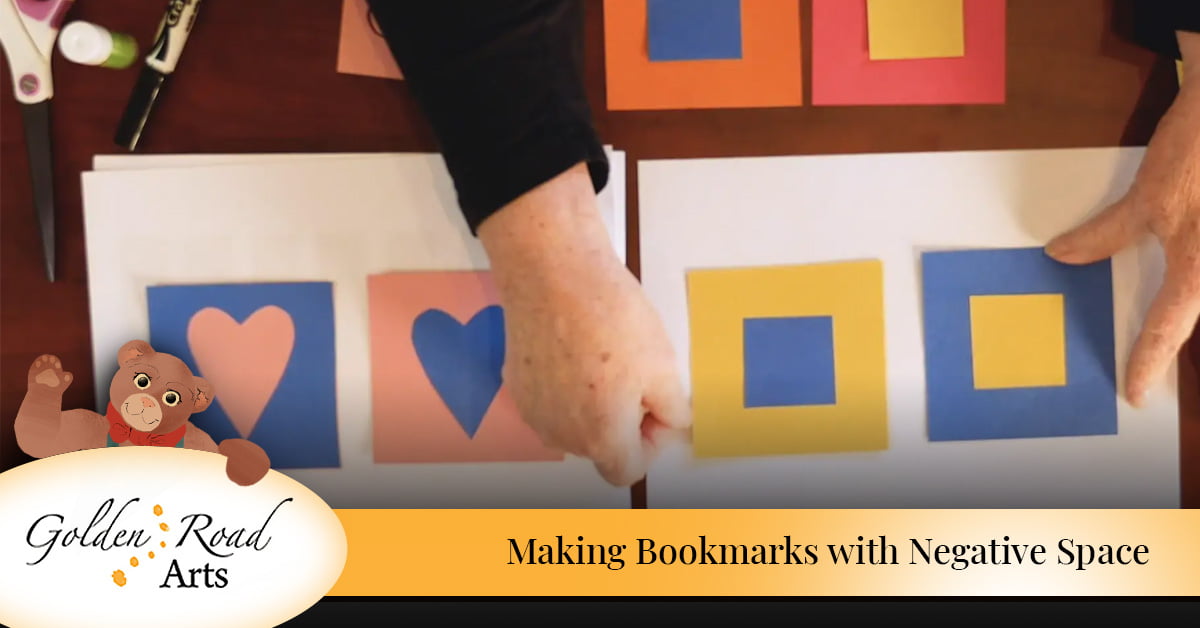
Have you ever noticed how art can create a strong sense of movement with repeating patterns and shapes? The use of lines, shapes, space and color can be showcased in kids’ art lessons to demonstrate this rhythm in action. Let’s take a look at how children can learn these techniques in their own art projects.
In this detailed lesson, Barbara Mason explains and demonstrates how to use different colors and shapes to create visual rhythm and “trick” your eyes with negative space. Rhythm in art is a technique to suggest movement or action. To practice the technique, students will cut out creative paper shapes and make bookmarks that use the concept of negative space.
Materials Required for Using Negative Space and Making Bookmarks
The materials required to follow along with the video are simple – paper, scissors and a glue stick.
Learn to Make Bookmarks Emphasizing Negative Space Video
Join Barbara as she demonstrates visual rhythm in art through the use of bookmarks and negative space.
Negative Space & Making Bookmarks With Barbara Mason Lesson Plan
Barbara Teaches How to Use Negative Space With Bookmarks
Follow along using the video transcription below as Barbara Mason explains the concept of visual rhythm in art and makes bookmarks to show the importance of negative space.
Golden Road Arts is a nonprofit that offers art classes for kids so they can make the most of their own creativity. Hi, this is Barbara Mason. Welcome back to Golden Road. We have a interesting little art lesson for you today and I want you to notice that I am wearing a mask. Artey behind me is also wearing his mask. We are trying to be very, very careful that we don’t get sick and that we don’t give anything to anybody else, but it’s pretty hard to talk through this mask and since I’m the only one here. Just me and the camera I’m going to take my mask off while I’m talking to you and then when I leave the room, I’m going to put my mask back on because we want to be very very careful.
So today we’re going to talk a little bit about negative and positive space. We have here two squares, one yellow, one blue, and the yellow square has a blue square in it, and the blue square has a yellow square in it. Now when you can look at these, which one do you think is bigger? Do you think that the blue square is bigger, or the yellow square is bigger? Well, this is kind of a trick question because really they are exactly the same size. But because one is brighter, this one looks bigger, and this one looks smaller. But really they are exactly the same size. It’s the same thing with the hearts. So we have these hearts here, and you can see that, one is blue, and one is pink. I want to show you how I got them to be exactly the same size. So what I did was I took my paper like this, and I have a blue paper and a yellow paper, and what I’m going to do is I’m going to fold them in half, and then I’m gonna cut them together. So then they’re going to be exactly the same size because I’m cutting them at the same size.
So what if I make a circle? Or sort of a circle. OK, so now I have a blue circle and a yellow circle. Let’s just move these over. We kind of fold this so they lay flat. So this is how it tricks your eye. So if we put the blue in the yellow, and the yellow in the blue, they don’t look the same size, but they are the same size.
Because we cut them together. So isn’t that interesting? How your eye can trick you to make you think that the yellow circle looks bigger than the blue circle when we know they’re exactly the same size because we cut them together. So this is just a really interesting thing that where your eye tricks your brain. So we’re going to put this aside for just a minute, and we’re going to talk about rhythm in artwork.
Rhythm is where you have things that are repeated. We talked about different kinds of lines, and these are repeated lines. So if you take images, and I cut all these strips here, so I’d have fun strips to play with. And if you take images and you glue them down like this one right across the other, kind of looks like a fence post, or a bunch of telephone poles when you’re driving. But this is rhythm so it’s almost like music where you would go boom boom boom boom boom boom boom. It’s almost like music, and that’s a visual rhythm, so it’s a little different than music rhythm. It’s a visual rhythm. And then what if we do like this, where we have boom boom boom boom boom boom boom. This is another visual rhythm and you can see that even though they’re offset a little bit, they still have a rhythm. And then what if we do this? Does this look like a rhythm? This is harder to see this is a rhythm because these are very different. Not only are they going in different directions, but there are different sizes. But if we could repeat this again, then it would certainly be a rhythm. So what if we do something like this? This is really hard to say this is a rhythm, isn’t it? It’s very very difficult because for one thing, there’s only two, and they are different shapes. Even though they’re similar colors, they are different shapes. So this is a very hard to see the rhythm in this.
One of the things that I’m going to do here is we are going to make some bookmarks. What I did is I took my paper, and I made some lines on it. That were just random squiggly lines. So I just went like this. And then I cut them together so I have all these pieces that were cut random. So if I laid them out, even though they’re different colors, this would be kind of a rhythm, wouldn’t it? If they were all the same shape, even though they’re different colors. But what I decided to do is I decided to glue them down to another piece of paper to make a bookmark. So I have a long piece of paper here, and because we know that the flat side of this is going to be the flat side of here, we can pretty much line this up. We could do it that way. Or we could do it this way. Or we could actually even put it in the middle. It wouldn’t matter because the sides line up. Then we could take a red one. And we could say, hmm, how am I am going to do this red one? What if I do it like this? Do I have another shape here? What if I do this one and I do this one at the top, this yellow one. So there. So this one I’ve already glued down, this one isn’t glued down yet, but we can do that with our glue. We have our glue right here. I’m a big fan of glue sticks. We are going to glue the red one right here, acrossed here. We can just line up the edges. So do you think this is a rhythm? I don’t know. I think if we did enough of them the same, it would be a rhythm. I don’t know if I put that back in exactly the right place, but pretty close. OK, so there’s our bookmark. Cut out of our lines that were curved. So if we did a couple of these that were the same, it would be kind of a rhythm.
We can take these mark these papers and we can say, OK, let’s make a rhythm here. What kind of a rhythm would this be? What if each one bent a little bit? What if it went like this? What if it bent so far? What if it bent so far that it almost went around in a circle. Would that be a rhythm? I think it would be. So one of the things that I want you to do when you go outside today, or even in your house, I want you look around, and I want you to see things that are rhythms. I want you to see things that repeat because that’s a rhythm, a visual rhythm.
So thank you for coming to see me at Golden Road today. And I hope when I see you next time that you will have looked at lots of visual rhythms, and you will be able to see them right away. Telephone poles, fence posts, just anything where you have things that repeat. Even trees could be a rhythm if they repeat one after the other. Thanks so much for coming to see me at Golden Road and I’m going to put my mask back on because I’m going to be leaving so have a good day and I’ll see you next time.
Access Engaging Art Tutorials for Kids
Are you a parent or teacher looking for the best quality instructional art content for elementary and middle school kids? At Golden Road Arts, we create free art lessons across a range of topics. Please also consider donating here.

